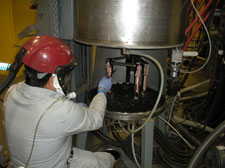Home > Press > NIOSH Releases New Nanotechnology Workplace Design Recommendations
 |
Abstract:
Realizing the promise of any scientific advancement requires understanding of its potential human health effects, and its safe and responsible development, even at the level of engineered nanomaterials, which can be nearly atomic-sized. The National Institute for Occupational Safety and Health (NIOSH) launched four new products this week intended to provide options to companies for controlling possible exposure of their workers to nanomaterials on the job.
NIOSH Releases New Nanotechnology Workplace Design Recommendations
Atlanta, GA | Posted on March 13th, 2018Engineered nanomaterials are intentionally produced to have at least one primary dimension less than 100 nanometers (nm). These very small particles have unique shapes and physical and chemical properties. These materials become desirable for specific product applications in areas including medicine, electronics, biomaterials, and consumer products. Workers in industries that use or make these uniquely engineered nanomaterials may inhale nanoparticles on a daily basis, posing a potential respiratory hazard.
“Researching, developing, and utilizing these nano properties is at the heart of new technology, just as worker safety is at the heart of what we do at NIOSH,” said NIOSH Director John Howard, M.D. “The information contained in these new workplace design solution documents provide employers with strategic steps towards making sure their employees stay safe while handling nanomaterials.”
The four new documents provide helpful recommendations on minimizing exposures during common processes and tasks, including:
handling and weighing of nanomaterials when scooping, pouring and dumping;
harvesting nanomaterials and cleaning out reactors after materials are produced;
processing of nanomaterials after production;
working with nanomaterials of different forms, including dry powders or liquids.
Each workplace design solutions document provides key tips on the design, use, and maintenance of exposure controls for nanomaterial production, post processing, and use. The poster poses questions that employers and workers should consider before starting work with a nanomaterial. For each question, the poster provides options to reduce exposures to nanomaterials based on the physical form. The poster can be displayed in a lab or work environment, making it an easily accessible reminder of the important health and safety considerations for working with nanomaterials.
To access the products, and for more information about nanotechnology research at NIOSH, please visit https://www.cdc.gov/niosh/topics/nanotech/pubs.html
NIOSH is the federal institute that conducts research and makes recommendations for preventing work-related injuries and illnesses. More information about NIOSH can be found at www.cdc.gov/niosh.
####
For more information, please click here
Contacts:
1600 Clifton Road Atlanta, GA 30329-4027 USA
800-CDC-INFO (800-232-4636), TTY: 888-232-6348
https://wwwn.cdc.gov/dcs/RequestForm.aspx
Nura Sadeghpour
(202) 245-0673
Copyright © CDC
If you have a comment, please Contact us.Issuers of news releases, not 7th Wave, Inc. or Nanotechnology Now, are solely responsible for the accuracy of the content.
| Related News Press |
News and information
![]() Simulating magnetization in a Heisenberg quantum spin chain April 5th, 2024
Simulating magnetization in a Heisenberg quantum spin chain April 5th, 2024
![]() NRL charters Navy’s quantum inertial navigation path to reduce drift April 5th, 2024
NRL charters Navy’s quantum inertial navigation path to reduce drift April 5th, 2024
![]() Discovery points path to flash-like memory for storing qubits: Rice find could hasten development of nonvolatile quantum memory April 5th, 2024
Discovery points path to flash-like memory for storing qubits: Rice find could hasten development of nonvolatile quantum memory April 5th, 2024
Standards/Certifications
![]() Oxford Instruments NanoScience achieves the latest ISO9001:2015 certification March 2nd, 2017
Oxford Instruments NanoScience achieves the latest ISO9001:2015 certification March 2nd, 2017
![]() UK NANOSAFETY GROUP publishes 2nd Edition of guidance to support safe working with nanomaterials May 30th, 2016
UK NANOSAFETY GROUP publishes 2nd Edition of guidance to support safe working with nanomaterials May 30th, 2016
Govt.-Legislation/Regulation/Funding/Policy
![]() NRL charters Navy’s quantum inertial navigation path to reduce drift April 5th, 2024
NRL charters Navy’s quantum inertial navigation path to reduce drift April 5th, 2024
![]() Discovery points path to flash-like memory for storing qubits: Rice find could hasten development of nonvolatile quantum memory April 5th, 2024
Discovery points path to flash-like memory for storing qubits: Rice find could hasten development of nonvolatile quantum memory April 5th, 2024
![]() Chemical reactions can scramble quantum information as well as black holes April 5th, 2024
Chemical reactions can scramble quantum information as well as black holes April 5th, 2024
Announcements
![]() NRL charters Navy’s quantum inertial navigation path to reduce drift April 5th, 2024
NRL charters Navy’s quantum inertial navigation path to reduce drift April 5th, 2024
![]() Discovery points path to flash-like memory for storing qubits: Rice find could hasten development of nonvolatile quantum memory April 5th, 2024
Discovery points path to flash-like memory for storing qubits: Rice find could hasten development of nonvolatile quantum memory April 5th, 2024
Safety-Nanoparticles/Risk management
![]() Tests find no free-standing nanotubes released from tire tread wear September 8th, 2023
Tests find no free-standing nanotubes released from tire tread wear September 8th, 2023
![]() Billions of nanoplastics released when microwaving baby food containers: Exposure to plastic particles kills up to 75% of cultured kidney cells July 21st, 2023
Billions of nanoplastics released when microwaving baby food containers: Exposure to plastic particles kills up to 75% of cultured kidney cells July 21st, 2023
|
|
||
|
|
||
| The latest news from around the world, FREE | ||
|
|
||
|
|
||
| Premium Products | ||
|
|
||
|
Only the news you want to read!
Learn More |
||
|
|
||
|
Full-service, expert consulting
Learn More |
||
|
|
||








